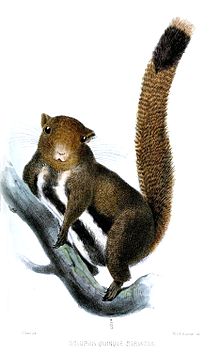Anderson croissant
| Anderson croissant | ||||||||||||
|---|---|---|---|---|---|---|---|---|---|---|---|---|
| Systematics | ||||||||||||
|
||||||||||||
| Scientific name | ||||||||||||
| Callosciurus quinquestriatus | ||||||||||||
| ( Anderson , 1871) |
The Anderson squirrel ( Callosciurus quinquestriatus ) is a species of squirrel from the genus of the real beautiful squirrel ( Callosciurus ) in South Asia.
features
The Anderson croissant reaches a head-trunk length of 20 to 22 centimeters and a weight of about 250 to 320 grams. The tail reaches a length of about 18 to 21 centimeters and is therefore about as long as the rest of the body. The rear foot becomes 44 to 55 millimeters long, the ear reaches a length of 18 to 23 millimeters. The back fur of the animals is grayish olive brown to olive yellow with a reddish tinge. The underside is white with one to three black or dark brown stripes, which are interrupted by white stripes and thus result in the eponymous five stripes ("quinquestriatus" means "five stripes"). The middle black stripe runs along the middle of the body over the stomach. The outermost black stripe is visible laterally and thus sharply separates the back and stomach colors from each other. The chin and throat are gray. The tail corresponds to the back color with black and reddish markings and a black tip.
The skull has a total length of 49 to 52 millimeters. Its appearance corresponds to that of the Pallas squirrel , but the anterior area of the nasals is wider and flattened and narrows posteriorly.
distribution
The Anderson squirrel occurs in South Asia in the southwest of the province of Yunnan , People's Republic of China , as well as the neighboring Myanmar .
Way of life
The Anderson squirrel mainly uses the mountain forests at altitudes over 1000 meters as a habitat, but can also be found in the lowlands. Like all other species of the genus, the species is primarily arboric ( arboricol ). The animals live as solitary animals or in small family groups and feed primarily on plants, and more rarely on insects.
The Anderson squirrel builds nests from twigs on the outer branches of small trees. There are hardly any data on reproduction, there is evidence of a female caught in March with an embryo .
Systematics

The Anderson squirrel is classified as an independent species within the genus of the real beautiful squirrel ( Callosciurus ), which consists of 15 species. The first scientific description comes from John Anderson from 1871, who described the species from Ponsee near Bhamo in what is now Myanmar . He named them as Sciurus quinquestriatus and described them together with two other species in the Proceedings of the general meetings for scientific business of the Zoological Society of London . Sometimes the species was also regarded as a subspecies of the Pallas squirrel ( C. erythraeus ), with which it occurs sympatric .
Within the species, two subspecies are distinguished with the nominate form :
- Callosciurus quinquestriatus quinquestriatus : nominate form; Distribution in the southern part of the distribution area in Myanmar to the border area with China. Compared to the second subspecies, the shape has shorter black stripes, in which the middle stripe does not extend into the genital region and the two outer stripes lie between the legs. The white stripes, on the other hand, are longer.
- Callosciurus quinquestriatus imarius : Distribution in the northern part of the distribution area in China and Myanmar. Compared to the first subspecies, the shape has longer black stripes, in which the middle stripe extends into the genital region and in the males on the testicles and the two outer stripes also include the legs. The white stripes, on the other hand, are shorter.
Smith & Yan Xie 2009 distinguish three subspecies in China, the two mentioned and the third subspecies Callosciurus quinquestriatus sylvester .
Status, threat and protection
The Anderson squirrel is classified as Near Threatened by the International Union for Conservation of Nature and Natural Resources (IUCN) due to its comparatively small distribution area of less than 20,000 km 2 and existing habitat changes. The stocks are likely to be in decline. No further causes for a potential endangerment of the species are known.
supporting documents
- ↑ a b c d e f g h Robert S. Hoffmann, Andrew T. Smith: Anderson's Squirrel. In: Andrew T. Smith , Yan Xie: A Guide to the Mammals of China. Princeton University Press, Princeton NJ 2008, ISBN 978-0-691-09984-2 , pp. 184-185.
- ↑ a b c d Richard W. Thorington Jr., John L. Koprowski, Michael A. Steele: Squirrels of the World. Johns Hopkins University Press, Baltimore MD 2012, ISBN 978-1-4214-0469-1 , pp. 151-152.
- ↑ a b c d Callosciurus quinquestriatus in the IUCN Red List of Threatened Species 2014.2. Posted by: D. Lunde, JW Duckworth, B. Lee, RJ Tizard, 2008. Retrieved October 22, 2014.
- ^ A b John Anderson : On three new species of squirrels from Upper Burma and the Kakhyen Hills, between Buhrma and Yunan. In: Proceedings of the general meetings for scientific business of the Zoological Society of London. 1871.
- ↑ a b c Callosciurus quinquestriatus In: Don E. Wilson , DeeAnn M. Reeder (Ed.): Mammal Species of the World. A taxonomic and geographic Reference. 2 volumes. 3. Edition. Johns Hopkins University Press, Baltimore MD 2005, ISBN 0-8018-8221-4 .
literature
- Robert S. Hoffmann, Andrew T. Smith: Anderson's Squirrel. In: Andrew T. Smith , Yan Xie: A Guide to the Mammals of China. Princeton University Press, Princeton NJ 2008, ISBN 978-0-691-09984-2 , pp. 184-185.
- Richard W. Thorington Jr., John L. Koprowski, Michael A. Steele: Squirrels of the World. Johns Hopkins University Press, Baltimore MD 2012, ISBN 978-1-4214-0469-1 , pp. 151-152.
Web links
- Callosciurus quinquestriatus inthe IUCN Red List of Threatened Species 2014.2. Posted by: D. Lunde, JW Duckworth, B. Lee, RJ Tizard, 2008. Retrieved October 22, 2014.